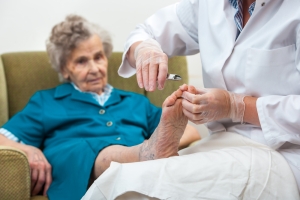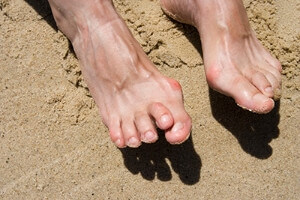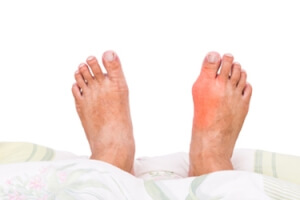BLOG

Where Are The Sesamoid Bones Located?
 The purpose of sesamoid bones is to provide force as you push off your toes while running. They are the two bones located under the big toe that are connected to tendons in the foot. If this area becomes inflamed, a condition that is known as sesamoiditis can develop. It may be caused by wearing shoes that do not have adequate room for the toes to move freely in, or it can happen from participating in repetitive running and jumping activities. After a proper diagnosis is performed, which typically consists of having an MRI taken, the correct treatment can begin. This may consist of wearing custom made orthotics which can aid in reducing pressure that is put on the sesamoid bones. It may also be beneficial to temporarily cease the activity which may have caused this condition. If you are suffering from sesamoiditis, it is suggested that you speak to a podiatrist who can recommend the best treatment for you.
The purpose of sesamoid bones is to provide force as you push off your toes while running. They are the two bones located under the big toe that are connected to tendons in the foot. If this area becomes inflamed, a condition that is known as sesamoiditis can develop. It may be caused by wearing shoes that do not have adequate room for the toes to move freely in, or it can happen from participating in repetitive running and jumping activities. After a proper diagnosis is performed, which typically consists of having an MRI taken, the correct treatment can begin. This may consist of wearing custom made orthotics which can aid in reducing pressure that is put on the sesamoid bones. It may also be beneficial to temporarily cease the activity which may have caused this condition. If you are suffering from sesamoiditis, it is suggested that you speak to a podiatrist who can recommend the best treatment for you.
Sesamoiditis is an unpleasant foot condition characterized by pain in the balls of the feet. If you think you’re struggling with sesamoiditis, contact one of our podiatrists of Livingston Foot Care Specialists. Our doctors will treat your condition thoroughly and effectively.
Sesamoiditis
Sesamoiditis is a condition of the foot that affects the ball of the foot. It is more common in younger people than it is in older people. It can also occur with people who have begun a new exercise program, since their bodies are adjusting to the new physical regimen. Pain may also be caused by the inflammation of tendons surrounding the bones. It is important to seek treatment in its early stages because if you ignore the pain, this condition can lead to more serious problems such as severe irritation and bone fractures.
Causes of Sesamoiditis
- Sudden increase in activity
- Increase in physically strenuous movement without a proper warm up or build up
- Foot structure: those who have smaller, bonier feet or those with a high arch may be more susceptible
Treatment for sesamoiditis is non-invasive and simple. Doctors may recommend a strict rest period where the patient forgoes most physical activity. This will help give the patient time to heal their feet through limited activity. For serious cases, it is best to speak with your doctor to determine a treatment option that will help your specific needs.
If you have any questions please feel free to contact our office located in North Bellmore, NY . We offer the newest diagnostic and treatment technologies for all your foot and ankle needs.
Sesamoiditis
Sesamoiditis is a condition in which the sesamoid bones in the forefoot become inflamed from physical activity. Sesamoid bones are bones that are not connected to other bones but are located in tendons or muscle. Two of these sesamoid bones are very small and located on the underside of the foot near the big toe. Athletes such as runners, baseball and football players, and dancers are likely to experience sesamoiditis. Those with high arched feet, flat feet, or runners who run on the ball of their foot are also prone to suffer from sesamoiditis.
Symptoms include pain or throbbing on the ball of the foot near the big toe. The pain generally starts with a mild throbbing but gradually builds up to shooting pain. Bruising, swelling, and redness are possible, but in most cases, these symptoms are not present. However, moving the big toe can result in pain and difficulty.
To conduct a diagnosis, the podiatrist will examine the ball of the foot and big toe. They will look for any outliers and check the movement of the toe. X-rays will be taken to rule out any other conditions and ensure that it is sesamoiditis.
Treatment for sesamoiditis is generally mild and includes rest, anti-inflammatory and pain medication, and ice treatments to deal with the swelling and pain. Orthotics may be needed with people who have flat or high arched feet to relieve pressure off the bones. In some cases the toe will be taped and immobilized to allow healing. The podiatrist may also decide to use a steroid injection to help with swelling as well. If you have sesamoiditis, you shouldn’t engage in any intensive activity, as it may inflame the area and worsen your pain. If the sesamoid bone has fractured, surgery may be required to remove the sesamoid bone.
If you are suffering from sesamoiditis or are experiencing symptoms similar to sesamoiditis, you should stop all physical activity that puts strain on the area. Furthermore you should see a podiatrist for a diagnosis to see if you have sesamoiditis.
Diabetic Foot Ulcers
 Wounds on the feet may be common for patients who are diabetic. This may be a result of decreased sensitivity in the feet that can come from neuropathy. It may be difficult to feel if there are any cuts or scrapes on the feet, and this can possibly cause extreme danger to the health of the foot. If any existing wounds become infected, they can progress to a foot ulcer. If it is left untreated, it may lead to amputation. There are methods that can be implemented which may help to reduce the possibility of an infection. These can include properly trimming the toenails, and performing a daily foot check to look for cuts or blisters. If you are diabetic, it is strongly suggested that you are under the care of a podiatrist who can help you to manage your diabetic condition.
Wounds on the feet may be common for patients who are diabetic. This may be a result of decreased sensitivity in the feet that can come from neuropathy. It may be difficult to feel if there are any cuts or scrapes on the feet, and this can possibly cause extreme danger to the health of the foot. If any existing wounds become infected, they can progress to a foot ulcer. If it is left untreated, it may lead to amputation. There are methods that can be implemented which may help to reduce the possibility of an infection. These can include properly trimming the toenails, and performing a daily foot check to look for cuts or blisters. If you are diabetic, it is strongly suggested that you are under the care of a podiatrist who can help you to manage your diabetic condition.
Diabetic foot care is important in preventing foot ailments such as ulcers. If you are suffering from diabetes or have any other concerns about your feet, contact one of our podiatrists from Livingston Foot Care Specialists. Our doctors can provide the care you need to keep you pain-free and on your feet.
Diabetic Foot Care
Diabetes affects millions of people every year. The condition can damage blood vessels in many parts of the body, especially the feet. Because of this, taking care of your feet is essential if you have diabetes, and having a podiatrist help monitor your foot health is highly recommended.
The Importance of Caring for Your Feet
- Routinely inspect your feet for bruises or sores.
- Wear socks that fit your feet comfortably.
- Wear comfortable shoes that provide adequate support.
Patients with diabetes should have their doctor monitor their blood levels, as blood sugar levels play such a huge role in diabetic care. Monitoring these levels on a regular basis is highly advised.
It is always best to inform your healthcare professional of any concerns you may have regarding your feet, especially for diabetic patients. Early treatment and routine foot examinations are keys to maintaining proper health, especially because severe complications can arise if proper treatment is not applied.
If you have any questions please feel free to contact our office located in North Bellmore, NY . We offer the newest diagnostic and treatment technologies for all your foot and ankle needs.
Diabetic Foot Care
Diabetes affects millions of people every year. Blood vessels located all over the body are damaged due to diabetes—even the blood vessels of the feet. Neuropathy, or nerve damage, can result from slower blood flow in the legs and feet. In diabetic patients, neuropathy is very important to monitor, as diabetics are at risk for developing ulcers.
Always washing and thoroughly drying the feet are pertinent parts of diabetic foot care. There should be a focus on cleaning between the toes. Even if no pain is felt, the entire foot should be examined for redness and sores. Neuropathy can often mask the pain of sores and ulcers and can cause these conditions to be overlooked. Use a mirror to examine the underside of your feet if needed. It is recommended that diabetics wear well-fitting socks.
Patients with diabetes should have their doctor monitor their blood levels because blood sugar levels play a huge role in diabetic care. Monitoring these levels on a regular basis is highly advised. It is very important to keep your blood sugar levels in the normal range, which can be determined by your physician. There are medications that may be prescribed to help with any neuropathy experienced by the diabetic patient. It is also advisable to visit a podiatrist if one is experiencing any conditions involving the feet, such as ingrown toenails, which in more severe cases can cause infection.
Diabetic feet must be inspected daily. Diabetic foot care at home is possible if a patient is provided with instructions from their podiatrist. Patients can relieve dry heels with creams or ointments. Suspected wounds should warrant an immediate call to the podiatrist. Gangrene is a serious problem for diabetics and can lead to sepsis and amputation in its worst cases. Early treatment and daily inspection of diabetic feet are keys to staying healthy.
Hormone Changes and Additional Weight May Affect the Feet
 Research has indicated the feet may undergo changes as pregnancy develops. Many pregnant women notice a loss of arches in their feet, and this may be indicative of flat feet. This can be a result of the weight of the growing fetus, and hormone changes may play a significant role. It is common for the feet to become swollen, and this typically occurs in the second and third trimesters. Moderate relief can be obtained when the feet are elevated for frequent periods of time throughout the day. Additionally, it may be beneficial to reduce excess salt intake, and it can be helpful to drink plenty of water daily. If you would like more information about how pregnancy can affect the feet, it is suggested that you schedule a consultation with a podiatrist.
Research has indicated the feet may undergo changes as pregnancy develops. Many pregnant women notice a loss of arches in their feet, and this may be indicative of flat feet. This can be a result of the weight of the growing fetus, and hormone changes may play a significant role. It is common for the feet to become swollen, and this typically occurs in the second and third trimesters. Moderate relief can be obtained when the feet are elevated for frequent periods of time throughout the day. Additionally, it may be beneficial to reduce excess salt intake, and it can be helpful to drink plenty of water daily. If you would like more information about how pregnancy can affect the feet, it is suggested that you schedule a consultation with a podiatrist.
Pregnant women with swollen feet can be treated with a variety of different methods that are readily available. For more information about other cures for swollen feet during pregnancy, consult with one of our podiatrists from Livingston Foot Care Specialists. Our doctors will attend to all of your foot and ankle needs.
What Foot Problems Can Arise During Pregnancy?
One problem that can occur is overpronation, which occurs when the arch of the foot flattens and tends to roll inward. This can cause pain and discomfort in your heels while you’re walking or even just standing up, trying to support your baby.
Another problem is edema, or swelling in the extremities. This often affects the feet during pregnancy but tends to occur in the later stages.
How Can I Keep My Feet Healthy During Pregnancy?
- Wearing orthotics can provide extra support for the feet and help distribute weight evenly
- Minimize the amount of time spent walking barefoot
- Wear shoes with good arch support
- Wear shoes that allow for good circulation to the feet
- Elevate feet if you experience swelling
- Massage your feet
- Get regular, light exercise, such as walking, to promote blood circulation to the feet
If you have any questions please feel free to contact our office located in North Bellmore, NY . We offer the newest diagnostic and treatment technologies for all your foot and ankle needs.
Foot Care for Pregnant Women
The natural weight that pregnant women gain causes their center of gravity to be completely altered. This causes them to have a new weight-bearing stance which adds pressure to the knees and feet. As a result, pregnant women often experience severe foot pain. The two most common foot issues experienced by women in their pregnancies are edema and over-pronation. It is important for all pregnant women to learn more about how to take care of their feet so they are more comfortable during their pregnancy.
Over-pronation, which is commonly referred to as flat feet, is caused when a person’s arch flattens out upon weight bearing. This causes the person’s feet to roll inward while walking. Pregnant women often experience this due to the sudden weight they gain.
Edema, also referred as swelling in the feet, typically occurs in the later part of the pregnancy. It is the result of the extra blood accumulated in the pregnant woman’s body. The enlarged uterus puts more pressure on the blood vessels in the pelvis which causes leg circulation to slow down. This causes blood to pool in the lower extremities.
Fortunately, there are ways to treat both edema and over-pronation. Edema can be treated by elevating the foot as often as possible. Wearing proper fitting footwear will also be helpful for those with edema. A treatment method for over-pronation could be orthotics. Orthotic inserts should be designed with appropriate arch support and medial rear foot for your foot.
It is best for pregnant women to buy new shoes during the day, because this is the time where swelling is at its peak. Pregnant women also shouldn’t rush when buying shoes. It is always advised that you make sure your shoes fit properly but this is especially important during pregnancy.
If you are a pregnant woman, you should consult with a podiatrist in order to make sure your feet are healthy throughout the entirety of your pregnancy.
Certain Medical Conditions May Cause Hammertoe
 A hammertoe is considered to be a deformity of the foot. It is also referred to as a “contracted toe” and is most likely noticed on the second and third toes. In severe cases, it can resemble a hammer, because the middle joint in the second toe bends in a downward direction. This deformity can happen for a variety of reasons. These can include having high arches, wearing shoes that do not have adequate room for the toes to move freely in, and prior toe injuries. Additionally, medical conditions such as arthritis and bunions may play a significant role in developing hammertoe. Mild relief can be found when the toes are gently stretched and wiggled, and it can help to wear shoes that have ample room in the toe area. Patients with a severe case of hammertoe may choose surgery, which can permanently straighten the toe. If you are afflicted with this condition, it is advised that you seek the counsel of a podiatrist who can guide you toward proper treatment options.
A hammertoe is considered to be a deformity of the foot. It is also referred to as a “contracted toe” and is most likely noticed on the second and third toes. In severe cases, it can resemble a hammer, because the middle joint in the second toe bends in a downward direction. This deformity can happen for a variety of reasons. These can include having high arches, wearing shoes that do not have adequate room for the toes to move freely in, and prior toe injuries. Additionally, medical conditions such as arthritis and bunions may play a significant role in developing hammertoe. Mild relief can be found when the toes are gently stretched and wiggled, and it can help to wear shoes that have ample room in the toe area. Patients with a severe case of hammertoe may choose surgery, which can permanently straighten the toe. If you are afflicted with this condition, it is advised that you seek the counsel of a podiatrist who can guide you toward proper treatment options.
Hammertoes can be a painful condition to live with. For more information, contact one of our podiatrists of Livingston Foot Care Specialists. Our doctors will answer any of your foot- and ankle-related questions.
Hammertoe
Hammertoe is a foot deformity that occurs due to an imbalance in the muscles, tendons, or ligaments that normally hold the toe straight. It can be caused by the type of shoes you wear, your foot structure, trauma, and certain disease processes.
Symptoms
- Painful and/or difficult toe movement
- Swelling
- Joint stiffness
- Calluses/Corns
- Physical deformity
Risk Factors
- Age – The risk of hammertoe increases with age
- Sex – Women are more likely to have hammertoe compared to men
- Toe Length – You are more likely to develop hammertoe if your second toe is longer than your big toe
- Certain Diseases – Arthritis and diabetes may make you more likely to develop hammertoe
Treatment
If you have hammertoe, you should change into a more comfortable shoe that provides enough room for your toes. Exercises such as picking up marbles may strengthen and stretch your toe muscles. Nevertheless, it is important to seek assistance from a podiatrist in order to determine the severity of your hammertoe and see which treatment option will work best for you.
If you have any questions, please feel free to contact our office located in North Bellmore, NY . We offer the newest diagnostic and treatment technologies for all your foot care needs.
Hammertoe
Hammertoe is a foot deformity that occurs due to an imbalance in the tendons, muscles, or ligaments that are responsible for holding the toes in their normal position. This condition may be caused by poor footwear, foot structure, trauma, and disease. The most common solution for hammertoe is to relieve the pain by changing your footwear and wearing orthotics. In severe cases, surgery may be required.
The shoes that are most likely to cause hammertoe are high heeled shoes or shoes that are too tight in the toe box. Tight shoes will force your toes to crowd together in a curled position. This position will likely continue when you take your shoes off. Another cause is trauma. When you stub your toe, you are increasing the chance that you will develop hammertoe.
There are risk factors that may make you more likely to develop this condition. Women are more likely to have the condition compared to men, and it is also more likely to appear in those who are older in age.
Many different foot problems can be avoided by wearing shoes that have adjustability, adequate toe room, and low heels. Furthermore, if you want to buy new shoes, you should look to purchase them at the end of the day and make sure you know your correct size. The importance of buying shoes at the end of the day is that your feet swell as the day progresses. You should also ensure that you are wearing your correct size because your shoe size may change as you grow older.
To diagnose someone with hammertoe, your podiatrist will need to conduct a thorough examination of your foot. Your doctor may even order an x-ray to evaluate the bones and joints of your feet and toes.
If you have hammertoe, your podiatrist may recommend that you wear shoes that fit you better along with inserts to place inside them. Additionally, he or she may suggest special exercises for you to perform to stretch your toes. One helpful exercise it to pick up marbles with your feet or crumple a towel with your toes.
Prior to meeting with your podiatrist, it will be helpful to make a list of all the symptoms you are experiencing. You should also make a note of medications you are taking and important personal information about your medical history.
Possible Causes of Gout
 Patients who are afflicted with gout are aware of the intense pain that accompanies this condition. The part of the foot that is most often affected is the side of the big toe. When a gout attack occurs, the joints in the big toe become inflamed and produce severe pain and discomfort. A common reason why gout attacks occur can be a result of foods that are eaten that have elevated purine levels. These types of foods can include red meat, shellfish, and drinks that have high sugar levels. This may play a significant role in causing crystals to form in the joints of the big toe, and it may become red and swollen. Genetic factors may contribute to the onset of gout, in addition to existing medical conditions such as diabetes and high blood pressure. Preventive measures can be implemented that may help reduce gout attacks from occurring. These can consist of eating healthy foods that have low purine levels, and incorporating a gentle exercise program into your daily routine. If you are prone to experiencing gout attacks, it is strongly advised that you consult with a podiatrist who can properly treat this condition.
Patients who are afflicted with gout are aware of the intense pain that accompanies this condition. The part of the foot that is most often affected is the side of the big toe. When a gout attack occurs, the joints in the big toe become inflamed and produce severe pain and discomfort. A common reason why gout attacks occur can be a result of foods that are eaten that have elevated purine levels. These types of foods can include red meat, shellfish, and drinks that have high sugar levels. This may play a significant role in causing crystals to form in the joints of the big toe, and it may become red and swollen. Genetic factors may contribute to the onset of gout, in addition to existing medical conditions such as diabetes and high blood pressure. Preventive measures can be implemented that may help reduce gout attacks from occurring. These can consist of eating healthy foods that have low purine levels, and incorporating a gentle exercise program into your daily routine. If you are prone to experiencing gout attacks, it is strongly advised that you consult with a podiatrist who can properly treat this condition.
Gout is a foot condition that requires certain treatment and care. If you are seeking treatment, contact one of our podiatrists from Livingston Foot Care Specialists. Our doctors will treat your foot and ankle needs.
What Is Gout?
Gout is a type of arthritis caused by a buildup of uric acid in the bloodstream. It often develops in the foot, especially the big toe area, although it can manifest in other parts of the body as well. Gout can make walking and standing very painful and is especially common in diabetics and the obese.
People typically get gout because of a poor diet. Genetic predisposition is also a factor. The children of parents who have had gout frequently have a chance of developing it themselves.
Gout can easily be identified by redness and inflammation of the big toe and the surrounding areas of the foot. Other symptoms include extreme fatigue, joint pain, and running high fevers. Sometimes corticosteroid drugs can be prescribed to treat gout, but the best way to combat this disease is to get more exercise and eat a better diet.
If you have any questions please feel free to contact our office located in North Bellmore, NY . We offer the newest diagnostic and treatment technologies for all your foot and ankle needs. Give us a call at (516) 826-0103.






